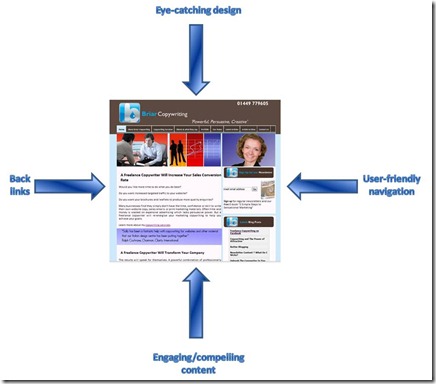Entries Tagged 'search engine optimisation' ↓
July 12th, 2010 — copywriter, freelance copywriter, keywords, search engine optimisation
 When people think about search engine optimisation, they immediately start thinking about keywords and search engine rankings. There’s nothing wrong with that, but if you spend every waking hour worrying about that, you might be missing something more concerning; something that could be happening right now.
When people think about search engine optimisation, they immediately start thinking about keywords and search engine rankings. There’s nothing wrong with that, but if you spend every waking hour worrying about that, you might be missing something more concerning; something that could be happening right now.
Every website owner should use Google Analytics. This small powerhouse of stats and graphs will show you how your website is performing. Information such as which keywords bring you the most traffic, sources of your traffic, which pages get the most hits and the geographical spread of your visitors is all at your finger tips. But one of the key stats that will show how effective your website is, is the bounce rate.
What is bounce rate?
The bounce rate is a figure that shows the percentage of visitors to your website that leave within the first 10 seconds. And that’s not good. If visitors are leaving that soon it shows that they haven’t found what they were looking for. A site with a low bounce rate (say below 30%) will be a website that is converting its visitors into customers. A site with a bounce rate of 50% and higher is one that isn’t converting – it’s failing.
If your rate is 50% and above, its time to take a look at your SEO.
Factors affecting bounce rate
Traffic to your website comes from a number of different sources:
- organic search results
- backlinks from referal sites
- repeat visitors
- social bookmarking traffic
- PPC traffic
The source with the lowest bounce rate should be your PPC traffic – if you use pay per click. If the highest rate comes from your organic traffic this would suggest that you have a mismatch with your keywords.
As a freelance copywriter it won’t come as any surprise that that is one of my keywords. So if people Google freelance copywriter they’ll find me. But what if I’d targeted something like marketing agency and they were looking for a company to deal with all their design and branding needs? When they land on my home page they’d find great information about my freelance copywriting services but no mention of design or branding. The result would be that they would click away from my site which would lead to a high bounce rate.

Therefore it is essential you ensure your keyword selection truly reflects what you do. Shed loads of traffic is useless without conversions.
But it might not be just down to your keywords. Here are other factors that may be causing people to click away from you site:
- too much advertising – this could be making your site look messy with too many messages
- videos and music – especially if they are on auto play as soon as your website is opened. The can be really annoying
- navigation choices – too many and your visitors will get confused, too few and they won’t know where to go next
- slow loading speed – peopel don’t like hanging around waiting for websites to load
- excessive corporate speak and jargon in your copy will be a huge turn off
- bad design – if you site looks unattractive it won’t encourage people to stay
So, if you are experiencing high bounce rates take a look at your site and compare it with the list above. Take another look at your keywords – are they really reflecting what your site is about?
If you can bring down your bounce rate you’ll boost your conversations.
July 5th, 2010 — copywriter, copywriting tips, internet marketing, search engine optimisation
 The internet is taking over – hardly breaking news, but it is if you are a business owner. More and more people are searching for local companies through the search engines so it’s never been more important to ensure you have a strong local SEO presence on the web.
The internet is taking over – hardly breaking news, but it is if you are a business owner. More and more people are searching for local companies through the search engines so it’s never been more important to ensure you have a strong local SEO presence on the web.
Many company websites concentrate on their products and services and omit their geographical details that will help them get found by consumers. With the advent of increased and improved mobile search, it is vital you stand out in your local area. And the best way to do that is by utilising the power of local search.
Location, location, location
If your company covers a specific geographical location, make sure those details are added to your HTML through page titles. You should also try and use these details within your copy and headings. But ensure you are sensible about it. Remember you are first and foremost writing for your reader – if you over do it, the page will look clumsy. Other areas for location information are within the footer along with your address and also within your internal hypertext linking structure. Instead of linking freelance copywriter, use a geographical reference such as Suffolk freelance copywriter.
YouTube
As well as optimising your website for local search terms, you can boost your presence by using video marketing. Upload your video to YouTube and then use very localised tags – without being spammy. The chances are (depending on the competitiveness of your keywords) you’ll be able to get these ranked and the more entries you can get on a front page local search results, the fewer your competitors can have.
Wider areas
Many buisnesses will serve multiple geographical areas. If this is the case, you should consider creating specific landing pages for each area. They should have unique content (you don’t want to fall foul of the duplicate content trap) and should be optimised for each specific area. Hypertext links within these pages can then drive your visitors to your main website.
Boost your profile
Social networking sites make it easy to spread your name and your business name to a wide audience. Set up social media profiles, again relating to your geographical region. But, as with the landing page content, make sure each description is different. You should also utilise Google Places, Yahoo local, and Bing Local to boost your local profile.
So the name of the game is local search – when creating your website always keep in mind your main business location and use it to its full potential.
June 28th, 2010 — copywriter, freelance copywriter, search engine optimisation, SEO copywriter

If you look back through this blog, you’ll find a number of posts about search engine optimisation.
I’ve tried to dispel the many myths that surround this concept – a concept many consider as mysterious.
Well, it’s not.
The SEO industry doesn’t have a great reputation. That is mainly due to the vast number of SEO Cowboys out there who love to take businesses for a ride by employing ‘black hat’ SEO practices. Investing in the services of a reputable SEO company and SEO copywriter will pay dividends.
So how do you know whether you are being taken for a ride?
- Keyword density
- Guaranteed front page listing
- META tags have no relevance
- Link out to relevant sites to boost SEO
- SEO is a short term solution
If a SEO company uses any of these phrase, run for the hills and don’t look back.
Plus, SEO is something that you can maintain once you have a strategy in place. The processes of link building, keyword research and keeping an eye on your analytics are all things that you can do.
To help ensure you don’t get lassoed by a cowboy outfit, check out these 10 SEO myths debunked by SEO Works – The Blog
Don’t forget the copy
I mentioned earlier about investing in great SEO copywriting. Even if your SEO strategy is working like a dream and you’re getting shed loads of visitors, if your website copy isn’t converting you are walking away from open wallets.
SEO copywriting is an art in its own right. Not only do you have to create informative, benefits driven, customer-orientated copy, it also has to be search engine friendly. That doesn’t mean cramming it with your keywords, but rather knowing where the optimum places are for those keywords.
So if you are serious about getting your website working for you, make sure you also find yourself a great SEO copywriter – one that really knows what they’re doing.
Sally Ormond is a leading SEO Copywriter – get in touch now and make sure your website copy carries clout.
June 23rd, 2010 — copywriter, freelance copywriter, search engine optimisation, SEO copywriter
 As a copywriter I have a lot of people coming to me for SEO copywriting.
As a copywriter I have a lot of people coming to me for SEO copywriting.
More and more people are beginning to appreciate the power of the internet as a marketing tool. They also realise that if they are to be found, they have to get to get to grips with search engine optimisation.
For many, that still seems to mean stuffing as many keywords as possible into their copy. Please, please don’t do that.
SEO copy is not about how many times you can fit a word or phrase onto a page. If you do, you’ll end up with something that is unreadable, unattractive and that won’t convert your visitors into customers.
SEO copywriting is about understanding where your keywords and phrases need to go to have the most effect. How to layout your text to make it readable. And how to position your writing so it’s informative, benefits driven and so it talks to your reader.
All of that takes some doing so if you need help, get in touch and I’ll be happy to provide you with a quote to take your business forward.
Anyway, enough of that – this blog post is about a different form of SEO.
If you look back through this blog, and indeed any other that you follow, you’ll notice I use images a lot.
There are several reasons for this:
- They make the page look nice
- They can pique your readers’ curiosity
- They help with SEO
That final point is one that is often overlooked. After all they are only images and the search engine spiders don’t have eyes.
That may be true, but there are a number of ways your images can help your blog posts and website copy in terms of search engine optimisation.
Are you using your images to the max?
I stumbled across a blog post by the Top Rank online marketing blog the others day that goes into this exact subject.
Their post 6 Tips on Image SEO gives valuable information on how to make the most out of using images in your website.
In an increasingly competitive online world, every ounce of SEO power you can utilise for your website is worth its weight in gold.
Are you using your images to their full potential?
Sally Ormond – freelance copywriter
May 19th, 2010 — copywriter, freelance copywriter, search engine optimisation, seo, SEO copywriter

I am a search engine optimisation copywriter (that’s just one of the copywriting services I offer) and so have a good idea about what it takes to get your website ranking well in Google. But there’s more to it that a bit of keyword research and great copy.
There are several factors that have to work together if you are going to get great results:

SEO can be a complex subject, especially if you are new to it all. So, I’ve listed below the 5 basics of search engine optimisation.
1. Keyword research
Before you do anything else, research your keywords. These are the terms real people use to search for your product or service. Although you can guess what people use, there’s no substitute for research:
-
analyse your own Google analytics (this is especially if you already have a website that you are looking for give an SEO make-over to) to see what terms people are using to find you.
-
Do some market research – ask your customers how they found you and if it was through a Google search, what term(s) they used.
-
Social networking – see what people are talking about. Engage with them and ask their advice.
-
Look at what your competitors are doing and what keywords they’re targeting.
-
Don’t overlook local (geographic) terms.
Once you’ve done your research and made a list of primary and secondary keywords, don’t just stop there. You will have to test your keywords constantly to ensure you are targeting the phrases and words that will generate you the most traffic.
2. SEO friendly infrastructure
Before you get to the point of building your website or writing your web copy, you must decide which pages will be used for which keywords. Your Home Page will target your primary words/phrase whereas your sub pages will target your secondary phrases.
3. SEO copy
SEO copy isn’t just the copy that appears on your web pages. You must ensure that your Page title tags use the keywords relevant to that page as identified when looking at your infrastructure.
Then there are your META descriptions. Although these don’t have a direct influence on your SEO, they will have an effect on the number of click-throughs you get. The META description is the text that appears below the page title in your search results page:

By using your keywords within that description, you will show the relevance of your page in relation to the search term and therefore increase your chances of getting that all important click-through. If you don’t add a META description, Google will just take a snippet of text from anywhere on your page. Therefore to ensure its relevance, make sure you provide one.
The next place you need to use your keywords is in your headings – these are the H1 and H2 tags (which go all the way down to H6). Again these are prominent locations which will be picked up by Google. Your primary keywords will go in H1 and your secondary ones will go in H2 onwards. Remember though not to just stuff these areas with keywords. They should be there as part of a meaningful phrase or sentence.
Finally, there’s your website copy itself – if you write naturally the keywords will appear within your text. Whatever you do, don’t be tempted to stuff your copy with keywords. The result will be clumsy and unreadable.
4. Build your links
The final aspect of SEO is link building. The more quality and relevant one way links that point to your site, the higher you’ll appear in the search engine results. Building links should be an ongoing process – there is no quick fix for this. You can generate links in a number of ways:
- Write content for other sites and link back through hypertext links (using your keywords)
- List your website in directories
- Comment on blogs in your industry
- Participate in forums (again linking back to your site by using a link in your signature)
- Write guest blog posts for other people
So they are the basics of SEO. Remember you need to look at everything – your website construction and navigation as well as your copy. All elements have to work together if you want to achieve great results. But this isn’t a quick fix. SEO takes time and constant monitoring – but get it right, and the benefits speak for themselves.
 When people think about search engine optimisation, they immediately start thinking about keywords and search engine rankings. There’s nothing wrong with that, but if you spend every waking hour worrying about that, you might be missing something more concerning; something that could be happening right now.
When people think about search engine optimisation, they immediately start thinking about keywords and search engine rankings. There’s nothing wrong with that, but if you spend every waking hour worrying about that, you might be missing something more concerning; something that could be happening right now.
 The internet is taking over – hardly breaking news, but it is if you are a business owner. More and more people are searching for local companies through the search engines so it’s never been more important to ensure you have a strong local SEO presence on the web.
The internet is taking over – hardly breaking news, but it is if you are a business owner. More and more people are searching for local companies through the search engines so it’s never been more important to ensure you have a strong local SEO presence on the web.
 As a
As a 







